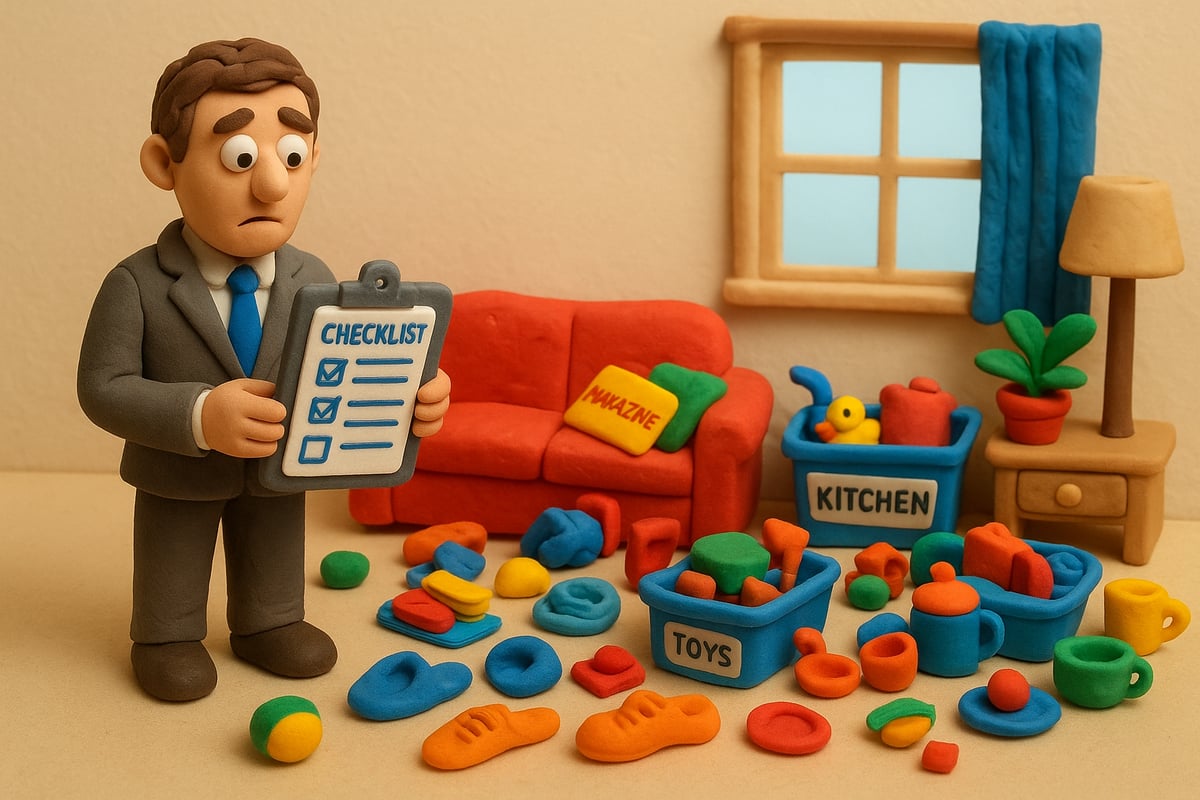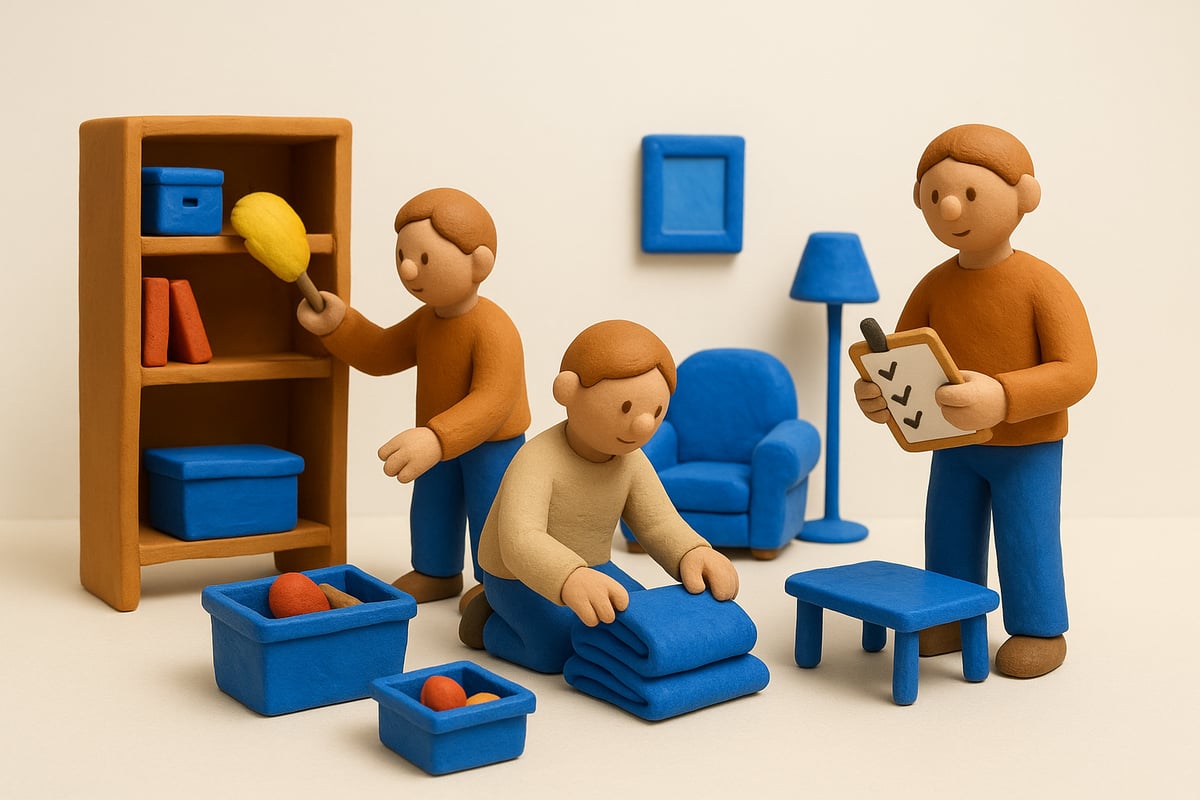Oct 27, 2025
How to Remove Clutter from Real Estate Photos: Expert Guide 2025

A cluttered real estate photo can instantly turn away potential buyers and cost sellers thousands in lost value. In today’s competitive market, first impressions matter more than ever, with buyers making decisions in seconds based on images alone.
This expert guide reveals how to remove clutter from real estate photos using the latest strategies for 2025. Whether you are a real estate professional, photographer, or homeowner, you will find practical steps and cutting-edge tools to boost your property’s visual appeal.
Discover the impact of clutter, essential preparation tips, manual and digital decluttering methods, AI-powered solutions, and proven best practices. Let’s transform your listings and maximize their potential.
The Impact of Clutter on Real Estate Listings
Clutter in real estate photos can quietly sabotage a listing’s potential, diminishing both property value and buyer interest. Many sellers overlook how distracting items in the background can draw attention away from a home’s best features. In today’s market, understanding how to remove clutter from real estate photos is not just a recommendation—it’s a necessity for achieving top results.

Why Clutter Hurts Property Value
Clutter not only makes spaces look smaller but also masks architectural highlights that could set a property apart. According to the National Association of Realtors, 85% of buyers say listing photos are the most important factor in deciding which homes to tour. Properties with clean, decluttered photos sell up to 73% faster, and clutter can reduce perceived value by 5 to 15%. Before-and-after photo comparisons routinely show that when you remove clutter from real estate photos, engagement noticeably increases. For a deeper dive, the Impact of Virtual Decluttering on Real Estate Sales details how virtual decluttering can lead to more showings and higher offers.
Buyer Psychology and First Impressions
Today, 95% of buyers begin their search online, making first impressions more critical than ever. Visual clutter creates an immediate, lasting negative impression that can be difficult to overcome. Clean, open spaces in photos help buyers imagine themselves living in the home, fostering a stronger emotional connection. Removing personal items and unnecessary objects is essential to remove clutter from real estate photos and allow buyers to focus on the property’s potential. Case studies consistently show that decluttered listings spend less time on the market and attract more competitive offers.
Digital Competition in 2025
With the rise of virtual tours and high-resolution photography in 2025, expectations for listing quality have never been higher. In crowded digital marketplaces, listings with poor photos are often skipped entirely. To stand out, it is vital to remove clutter from real estate photos so every image looks polished and inviting. Competitive cities like New York and Los Angeles show that top-performing listings consistently feature flawless, decluttered visuals. As buyers scroll quickly through dozens of options, only the most visually compelling homes get noticed. For every property, the ability to remove clutter from real estate photos is a decisive factor in attracting attention and driving faster sales.
Preparing for Decluttering: Pre-Photo Checklist
Preparing to remove clutter from real estate photos starts long before the camera clicks. The right pre-photo checklist ensures every room is visually appealing and ready to capture buyers’ attention. A methodical approach helps real estate professionals, photographers, and homeowners maximize each property’s potential and avoid costly oversights.

Assessing the Space
Start by walking through the entire property to identify clutter hotspots. Common problem areas include kitchens, living rooms, and bedrooms, where everyday items tend to accumulate. Use a detailed checklist to make sure nothing is overlooked—pay attention to countertops, open shelving, and entryways.
For added efficiency, consider using digital tools like the Declutter Room Tool for Realtors to help you systematically remove clutter from real estate photos. Downloadable checklists can guide agents or homeowners, ensuring a comprehensive review before the photo shoot.
Staging Essentials
Effective staging is vital to remove clutter from real estate photos and increase buyer appeal. Begin by taking out all personal items, such as family photos, collectibles, and children’s artwork. Excess décor and unnecessary furniture should be stored away to create a neutral, inviting space.
Neutralizing each room allows buyers to imagine themselves living there. According to recent data, 83% of agents agree that staging makes it easier for buyers to visualize a property’s potential, leading to faster sales and higher offers.
Lighting and Angles
Lighting plays a crucial role in showcasing decluttered spaces. Natural light is ideal, so open curtains and blinds to brighten rooms. Supplement with soft, even artificial lighting if needed, positioning lights to reduce shadows that can make clutter stand out.
Use strategic camera angles to highlight spaciousness and cleanliness. A well-lit, thoughtfully composed photo enhances the impact of your efforts to remove clutter from real estate photos, making each room look larger and more appealing.
Organizing for Efficiency
Organization is key to a smooth decluttering process. Schedule time for cleaning and decluttering at least a day before the shoot. Assign specific tasks to homeowners or enlist professional organizers for larger properties.
Utilize storage bins or offsite storage to temporarily relocate items. Keeping the workflow organized ensures every area is addressed and nothing is left behind, helping you efficiently remove clutter from real estate photos without last-minute stress.
Common Mistakes to Avoid
Even with careful planning, some mistakes can undermine your efforts. Avoid leaving small items in corners or behind doors, which are easily missed but visible in wide-angle shots. Do not forget closets, garages, and outdoor spaces, as buyers often scrutinize every photo.
Over-staging is another pitfall—it can make rooms look artificial or crowded. Focus on simplicity, allowing the property’s best features to shine and ensuring your decluttering efforts deliver maximum impact.
Manual Decluttering Techniques for Real Estate Photos
A flawless first impression starts long before the camera clicks. To effectively remove clutter from real estate photos, a systematic approach is essential. By following these manual decluttering techniques, you can elevate property images, attract more buyers, and maximize listing value.

Step 1: Physical Decluttering Before the Shoot
Begin by removing all visible clutter from each room. Pay special attention to countertops, tables, and open shelving. Items like mail, toiletries, pet accessories, and small appliances should be stored out of sight. This step is critical to remove clutter from real estate photos and create an inviting atmosphere.
- Clear kitchen counters of gadgets and paperwork.
- Store toys and pet beds in closets or offsite.
- Remove shoes, coats, and bags from entryways.
A well-prepared space ensures buyers see the home itself, not distractions.
Step 2: Strategic Furniture Arrangement
Furniture layout has a significant impact on perceived space and flow. Rearranging or removing excess pieces will help remove clutter from real estate photos and make each room appear larger.
- Eliminate extra chairs or side tables that crowd the area.
- Position furniture to highlight natural walkways.
- Roll up oversized rugs that can make rooms feel smaller.
A minimalist arrangement draws attention to the room’s strengths and functionality.
Step 3: Neutralizing Décor
Personal and bold décor can detract from a buyer’s ability to visualize themselves in the space. Swap out family photos and statement pieces for neutral, universally appealing items to remove clutter from real estate photos.
- Choose simple bedding and minimal wall art.
- Store collectibles, trophies, and personalized décor.
- Replace patterned throws with solid colors.
Neutral spaces allow the property’s features to shine in every photo.
Step 4: Deep Cleaning and Maintenance
A spotless environment photographs best. Deep cleaning is essential to remove clutter from real estate photos, as even minor blemishes can become focal points in high-resolution images.
- Wash windows and polish floors for a gleaming finish.
- Repair scuffed paint and tighten loose hardware.
- Dust surfaces and light fixtures thoroughly.
According to industry data, clean homes attract up to 40% more online views, reinforcing the value of this step.
Step 5: Optimizing Room Functionality
Each room should clearly communicate its intended purpose. Remove items that could confuse buyers and stage the space to highlight its function, which helps remove clutter from real estate photos.
- Convert spare rooms into home offices or guest bedrooms.
- Remove gym equipment from living areas.
- Use simple props, like a desk and chair, to define spaces.
Purposeful staging makes listings more memorable and marketable.
Step 6: Final Walkthrough and Photo Prep
Before the photographer arrives, conduct a final walkthrough. Use a camera or phone to preview each space and catch any remaining issues. This last check guarantees you remove clutter from real estate photos and maintain a professional standard.
- Check behind doors and inside closets.
- Ensure outdoor spaces are tidy.
- Review a checklist to avoid missing key areas.
For comprehensive guidance on these manual steps and more, consult the Real Estate Photo Editing Guide, which offers practical tips for decluttering and preparing properties for photography.
Digital Decluttering: Editing Tools and Techniques
Digital decluttering is essential for anyone aiming to remove clutter from real estate photos and create listings that stand out in today’s competitive market. With the right software and workflow, you can transform cluttered rooms into inviting spaces that attract more buyers and maximize property value.
Basic Photo Editing Software
To effectively remove clutter from real estate photos, start with the right editing tools. Popular options include Adobe Photoshop, Lightroom, and GIMP. Each offers features for enhancing images and eliminating distractions.
Here’s a quick comparison:
| Software | Platform | Key Features | Cost |
|---|---|---|---|
| Photoshop | Windows, Mac | Clone, heal, layers | Subscription |
| Lightroom | Windows, Mac | Presets, batch edits | Subscription |
| GIMP | Windows, Mac | Free, open source | Free |
Use the clone stamp to paint over small objects, or the healing brush to blend away minor distractions. The crop tool helps frame your shot and remove clutter from real estate photos at the edges.
Test your edits by toggling before and after views. This ensures you do not accidentally remove important features when you remove clutter from real estate photos.
Advanced Editing for Real Estate
When basic tools are not enough, advanced editing steps in. Layer masking lets you erase unwanted objects without harming the background. Adjusting exposure and color balance brings out the natural brightness in each room, making the space look cleaner and more inviting.
For stubborn items like power cords or pet beds, object removal plugins can save time. Professionals often use AI-powered tools or manual retouching for seamless results. If you want to see how these methods work in practice, the Object Removal in Real Estate Photos guide offers practical examples and tips.
Always preview your edits on different screens to ensure you remove clutter from real estate photos consistently and accurately.
Batch Editing and Workflow Optimization
Large listing projects demand efficient workflows. Many photo editors allow you to remove clutter from real estate photos using batch processing and custom presets.
Here are some workflow tips:
- Apply global adjustments first (exposure, white balance).
- Use presets to speed up repetitive edits.
- Batch process similar photos to maintain consistency.
Batch editing can reduce post-production time by up to 50 percent, which is a major advantage when you need to remove clutter from real estate photos across dozens of listings.
Test your batch edits on a few images before applying them to all your photos. This helps catch any errors and ensures quality results.
Outsourcing Photo Editing
Sometimes, outsourcing is the most efficient way to remove clutter from real estate photos. Professional editors and virtual assistants can handle large volumes of images quickly and with a high level of polish.
Consider these points:
- Cost vs. time: Weigh the expense against the hours saved.
- Quality: Review sample edits to ensure standards.
- Turnaround: Clarify deadlines and revision policies.
Outsourcing allows agents and photographers to focus on staging and client service while experts remove clutter from real estate photos in the background.
Choose a reputable partner who understands real estate photography standards and ethical guidelines.
Legal and Ethical Considerations
When you remove clutter from real estate photos digitally, transparency is crucial. The National Association of Realtors recommends disclosing any edits that alter the actual condition of the property.
Avoid edits that mislead buyers, such as erasing permanent features or hiding damage. Instead, use digital decluttering to present the space at its best while remaining truthful.
Always double-check your images to confirm you only remove clutter from real estate photos, not structural elements or anything that could create false expectations.
By following these guidelines, you uphold professional standards and build trust with buyers and sellers alike.
AI-Powered Solutions for Effortless Decluttering
Artificial intelligence is rapidly changing how professionals remove clutter from real estate photos. Instead of spending hours painstakingly editing, you can now rely on powerful AI tools to handle much of the process in seconds. These platforms use machine learning, analyzing thousands of property images to understand what constitutes clutter and how to erase it seamlessly. The result is a streamlined workflow that delivers crisp, inviting images that attract more buyers and set listings apart in an increasingly competitive market.
How AI is Revolutionizing Real Estate Photo Editing
AI-powered editing tools are designed to intelligently remove clutter from real estate photos by identifying and erasing unwanted objects with minimal manual effort. These systems recognize items like toys, cords, and small furniture, then reconstruct the background to ensure a natural result. By automating this process, agents and photographers can focus on capturing the best angles, confident that distracting elements can be handled in post-production. The technology is particularly useful when tight deadlines make manual editing impractical or when multiple rooms need decluttering in a short time.
Benefits of AI Decluttering
The main advantage of using AI to remove clutter from real estate photos is the significant time savings. Traditional manual editing can take hours per property, but AI can process batches of images in minutes. This efficiency allows professionals to deliver polished photos quickly, giving listings a competitive edge. Consistency is another benefit, as AI ensures a uniform look across all images. For a deeper dive into how object removal enhances property appeal, see this Object Removal in Real Estate Photos. With AI, agents can list properties faster and make a stronger impression on buyers.
Key Features to Look for in AI Tools
When choosing AI solutions to remove clutter from real estate photos, look for these essential features:
- High object detection accuracy
- Advanced background reconstruction
- User-friendly interface
- Batch editing capabilities
- Integration with popular photo editing workflows
These features ensure that clutter is eliminated efficiently, and the final images maintain a natural, inviting look. Batch processing is particularly valuable for large listings, while seamless workflow integration helps teams collaborate effectively. Before committing to a tool, review sample outputs and test the interface to confirm it suits your needs.
Weezard AI: Next-Generation AI Decluttering for Real Estate Photos
Weezard AI stands out as a specialized platform built to remove clutter from real estate photos with maximum efficiency. Its intuitive drag-and-drop system and natural language prompts make editing accessible for both agents and photographers. Weezard AI supports batch processing and high-resolution output, so entire property portfolios can be optimized quickly. As virtual staging and AI-powered editing become industry standards, platforms like Weezard are leading the shift. For more on this trend, explore their AI Virtual Staging Insights to discover how digital decluttering and staging can elevate your listings.

Limitations and Best Practices
While AI tools are powerful, they are not flawless. Sometimes, an object may be partially removed, or small artifacts might remain, requiring manual touchups. Always review final images carefully to ensure nothing appears unnatural or misleading. For best results, combine AI solutions with a trained eye and manual editing skills. Transparency is also key—disclose any significant digital enhancements to maintain trust with buyers. As you remove clutter from real estate photos with AI, remember that ethical standards and quality control will always set your listings apart.
Best Practices for Decluttered Real Estate Photography in 2025
Maintaining best practices is essential if you want to remove clutter from real estate photos and set your listings apart in 2025. These proven strategies ensure every image is market-ready, visually appealing, and effective at capturing buyer interest.
Staying Ahead of Trends
In 2025, the demand to remove clutter from real estate photos continues to rise. Minimalism and neutral staging are more than trends—they are the standard. Virtual staging and AI decluttering tools are now industry essentials, enabling agents and photographers to showcase properties at their absolute best.
Top-performing agencies are already adopting full digital workflows. By integrating these innovations, professionals ensure their listings stay competitive and attract tech-savvy buyers.
Quality Control and Consistency
To consistently remove clutter from real estate photos, establish a decluttering checklist for every listing. This proactive approach guarantees nothing is overlooked, from kitchens to outdoor spaces.
Consistency across all marketing channels is vital. Listings with unified, decluttered visuals on MLS, social media, and print materials see significantly higher engagement. According to Real Estate Photography Statistics 2025, such listings achieve up to 30 percent more buyer interest, underscoring the importance of quality control.
Collaboration Between Agents, Photographers, and Editors
Teamwork is crucial when you remove clutter from real estate photos. Clear communication between agents, photographers, and editors ensures everyone understands decluttering expectations.
Share checklists and sample images before every shoot. Consider using a workflow template to streamline collaboration and maintain a cohesive visual standard. This approach results in smoother shoots and more effective property presentations.
Legal and Ethical Guidelines
When you remove clutter from real estate photos, always adhere to legal and ethical standards. Transparency with buyers about any digital enhancements builds trust and credibility.
Follow NAR ethics guidelines to avoid misleading edits. Never alter images in a way that misrepresents the property's true condition. Ethical editing supports your professional reputation and protects all parties involved in a sale.
Measuring Success and ROI
After you remove clutter from real estate photos, track your results. Monitor key metrics such as time-on-market, number of showings, and offer price.
A compelling case study shows that decluttering can boost perceived value and accelerate sales. For more insights, see Decluttering's Effect on Property Value. Use available tools to analyze listing performance and photo engagement, refining your process for even greater success.
Now that you’ve explored how clutter can dramatically impact real estate photos and discovered the power of AI and best practices for creating stunning, market-ready images, you’re ready to elevate your listings. Imagine transforming every photo into a clean, inviting space that attracts more buyers and accelerates sales—all with less time and effort. If you want to see these expert strategies in action and experience next-generation AI image editing for yourself, you don’t have to wait. Take the next step and Make magic!
Ready to jump in?
Experience the power of AI-driven image editing with Weezard AI. Professional results in seconds.

